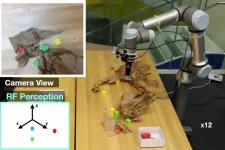Lessons from computer science can make medical devices fair for all
2021-04-01
(Press-News.org) Technology can be biased, and its design can disadvantage certain demographic groups. While efforts to address bias and promote fairness in technologies are rapidly growing in a variety of technical disciplines, Achuta Kadambi argues that similar growth is not occurring fast enough for medical engineering. "Although computer science companies terminate lucrative but biased facial recognition systems, biased medical devices continue to be sold as commercial products," writes Kadambi in a Perspective. Bias in medical devices results in undesirable performance variation across demographic groups and can greatly influence health inequality. For example, optical biosensors that use light to monitor vital signs like blood oxygenation have been shown to work differently on light versus dark skin. Since some of these measures relate to what could be serious medical prognoses, such a biased medical device could lead to disparate mortality outcomes for Black and dark-skinned patients. The author outlines three ways medical devices can suffer bias - they can exhibit physical bias, computational bias and interpretational bias. However, unlike similar issues faced in computer science, bias in medical devices often remains unaddressed. According to Kadambi, bias is routinely researched and actively addressed in computer science. For example, Amazon Inc. has recently banned the use of their facial recognition products by law enforcement until bias concerns within the software can be understood and fully resolved. Medical engineers could embrace the lessons learned from these areas to achieve fairness in medical devices and prevent health inequity. "Achieving fairness in medical devices is a key piece of the puzzle, but a piece nonetheless," writes Kadambi, noting that achieving true fairness goes beyond simple device engineering. "Even if one manages to engineer a fair medical device, it could be used by a clinical provider who has conscious or subconscious bias. And even a fair medical device from an engineering perspective might be inaccessible to a range of demographic groups," he writes.
For reporters interested in trends, an October 2019 Science study revealed how a nationally deployed healthcare algorithm - one of the largest commercial tools used by health insurers to inform health care decisions for millions of people each year - exhibited significant racial bias in its predictions of the health risks of black patients. The authors of the study, who showed that reformulating the algorithm led to an 84% reduction in racial bias, were working with the algorithm's developer to reduce bias at the time of the 2019 publication. https://science.sciencemag.org/cgi/doi/10.1126/science.aax2342
INFORMATION:
ELSE PRESS RELEASES FROM THIS DATE:
2021-04-01
In an analysis of thousands of fossil pollen and leaves spanning the Cretaceous-Paleogene (K/Pg) boundary, researchers found that the cataclysmic asteroid impact that resulted in the destruction of nearly 75% of all terrestrial life on Earth drastically restructured tropical forests, setting the stage for the evolution of what has become one of the planet's most diverse ecosystems - the neotropical rainforest. While the end-Cretaceous impact nearly 66 million years ago was catastrophic for terrestrial ecosystems worldwide, its long-term effects on tropical forests have remained a mystery. This is largely due to the lack of palaeobotanical exploration in the region, which has only just begun to provide ...
2021-04-01
An increase of dopamine in the brain's striatum triggers auditory hallucination-like experiences in mice, revealing a possible causal role for dopamine-dependent neurological circuits in symptoms of psychosis. These findings from a new study could inform novel targeted approaches to treating those with psychotic disorders, like schizophrenia. Auditory and visual hallucinations - perceptions of hearing or seeing something without observing external sensory stimuli - are central symptoms of psychotic disorders and are thought by some to be caused by excessive dopamine ...
2021-04-01
A single "super photon" made up of many thousands of individual light particles: About ten years ago, researchers at the University of Bonn produced such an extreme aggregate state for the first time and presented a completely new light source. The state is called optical Bose-Einstein condensate and has captivated many physicists ever since, because this exotic world of light particles is home to its very own physical phenomena. Researchers led by Prof. Dr. Martin Weitz, who discovered the super photon, and theoretical physicist Prof. Dr. Johann Kroha have returned from their latest "expedition" into the quantum world with a very special observation. They report of a new, previously ...
2021-04-01
(Santa Barbara, Calif.) -- Despite the fact that our planet is mostly ocean and human maritime activity is more intense than it has ever been, we know remarkably little about the state of the ocean's biodiversity -- the variety and balance of species that support healthy and productive ecosystems. And it's no surprise -- marine biodiversity is complex, human impacts are uneven, and species respond differently to different stressors.
"It is really hard to know how a species is doing by just looking out from your local coast, or dipping underwater on SCUBA," said Ben Halpern, a marine ecologist at the Bren School of Environmental Science & Management at UC Santa ...
2021-04-01
The humble lab mouse has provided invaluable clues to understanding diseases ranging from cancer to diabetes to COVID-19. But when it comes to psychiatric conditions, the lab mouse has been sidelined, its rodent mind considered too different from that of humans to provide much insight into mental illness.
A new study, however, shows there are important links between human and mouse minds in how they function -- and malfunction. Researchers at Washington University School of Medicine in St. Louis devised a rigorous approach to study how hallucinations are produced in the brain, providing a promising entry point to the development of much-needed new therapies for schizophrenia.
The study, published April 2 in ...
2021-04-01
Tropical rainforests today are biodiversity hotspots and play an important role in the world's climate systems. A new study published today in Science sheds light on the origins of modern rainforests and may help scientists understand how rainforests will respond to a rapidly changing climate in the future.
The study led by researchers at the Smithsonian Tropical Research Institute (STRI) shows that the asteroid impact that ended the reign of dinosaurs 66 million years ago also caused 45% of plants in what is now Colombia to go extinct, and it made way for the reign of flowering plants in modern tropical rainforests.
"We wondered how tropical rainforests changed after a drastic ecological perturbation such as the Chicxulub impact, so we looked for tropical plant fossils," said Mónica ...
2021-04-01
LA JOLLA--(April 1, 2021) Neurons lack the ability to replicate their DNA, so they're constantly working to repair damage to their genome. Now, a new study by Salk scientists finds that these repairs are not random, but instead focus on protecting certain genetic "hot spots" that appear to play a critical role in neural identity and function.
The findings, published in the April 2, 2021, issue of Science, give novel insights into the genetic structures involved in aging and neurodegeneration, and could point to the development of potential new therapies for diseases such Alzheimer's, Parkinson's and other age-related dementia disorders.
"This research shows for the first time that ...
2021-04-01
On the afternoon of April 13, 2018, a large wave of water surged across Lake Michigan and flooded the shores of the picturesque beach town of Ludington, Michigan, damaging homes and boat docks, and flooding intake pipes. Thanks to a local citizen's photos and other data, NOAA scientists reconstructed the event in models and determined this was the first ever documented meteotsunami in the Great Lakes caused by an atmospheric inertia-gravity wave.
An atmospheric inertia-gravity wave is a wave of air that can run from 6 to 60 miles long that is created when a mass of stable air is displaced by an air mass with significantly ...
2021-04-01
In recent years, robots have gained artificial vision, touch, and even smell. "Researchers have been giving robots human-like perception," says MIT Associate Professor Fadel Adib. In a new paper, Adib's team is pushing the technology a step further. "We're trying to give robots superhuman perception," he says.
The researchers have developed a robot that uses radio waves, which can pass through walls, to sense occluded objects. The robot, called RF-Grasp, combines this powerful sensing with more traditional computer vision to locate and grasp items that might otherwise be blocked from view. The advance could one day streamline e-commerce fulfillment in warehouses or help a machine pluck a screwdriver from a jumbled toolkit.
The research will be presented in May at the IEEE International ...
2021-04-01
Plant inducible defense starts with the recognition of microbes, which leads to the activation of a complex set of cellular responses. There are many ways to recognize a microbe, and recognition of microbial features by pattern recognition receptors (PRRs) outside the cell was long thought to activate the first line of defense: Pattern Triggered Immunity, or PTI. To avoid these defense responses, microbes of all kinds evolved the ability to deliver effector molecules to the plant cell, either directly into the cytoplasm or into the area just outside the cell, where they are taken up into the cytoplasm. ...
LAST 30 PRESS RELEASES:
[Press-News.org] Lessons from computer science can make medical devices fair for all





